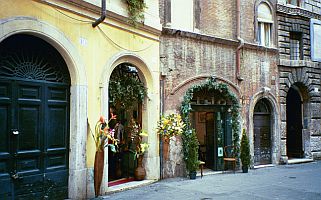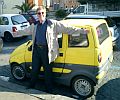Planning the trip
After researching ticket prices for several weeks, we took the plunge on New Year's Eve, beating the deadline to get bonus miles on American Airlines for booking before the end of the year. We chose American because we both have hundreds of thousands of frequent flyer miles accumulated on that airline, and we were hoping to use those to upgrade to business class. Unfortunately, the flights were so full (we later realized that we had chosen to take the trip at the same time as many "spring breakers" in the U.S.) we weren't able to upgrade. The thought of spending twenty hours in a coach seat wasn't very appealing, but we didn't have much choice in the matter.
Earlier, in my desire to someday be a polyglot, I had ordered sets of CDs by Michel Thomas that taught French, German, Italian, and Spanish. I chose the deluxe editions, which have eight CDs; they are also available in an introductory edition with just two CDs. I ripped the Italian CDs and transferred them to my iPod, and listened to them during my half hour commute to and from work. I like Mr. Thomas' approach to learning, which is to focus primarily on the structure of the language. Once that is learned, you can easily add to the vocabulary. To do that, I also studied a small phrase book and dictionary: Barron's Italian at a Glance. I liked the layout of it to just about every other phrase book/dictionary I've seen.
The final step was to find a place to stay. The two primary sources for us were Expedia.com and TripAdvisor.com. We looked over the reviews and choose the Mecenate Palace. It received many favorable reviews, and was located close to the train station and to Santa Maria Maggiore, one of the most beautiful churches in Rome.
Getting around in Rome
We primarily relied on our feet to get around in Rome—probably too much. While I ended each day fairly exhausted, Judy was suffering actual pain. The metro in Rome isn't as extensive as it was in Paris. It's essentially two lines that intersect at right angles. Consequently, we primarily relied on it to get us to our starting point for the day and, occasionally, getting us home at the end of the day.
Yet walking is the best way to see the old city, and almost all of the main attractions are within walking distance of each other. To quote Stephen Wright: "Everywhere is within walking distance if you have the time".  And time is the key. In later days we took a far more leisurely approach to walking—strolling really, taking the time to enjoy the scenery away from the main thoroughfares, with lots of sitting breaks. Even though we started with the intent not too try to cram too much into our trip, we walked too far our first day, when we were tired from the 10+ hours stuck in coach on the plane. That's when Judy's blisters began to form, and every day after that the walking just made them worse. We should have made use of the bus system, but for some reason we never investigated that.
And time is the key. In later days we took a far more leisurely approach to walking—strolling really, taking the time to enjoy the scenery away from the main thoroughfares, with lots of sitting breaks. Even though we started with the intent not too try to cram too much into our trip, we walked too far our first day, when we were tired from the 10+ hours stuck in coach on the plane. That's when Judy's blisters began to form, and every day after that the walking just made them worse. We should have made use of the bus system, but for some reason we never investigated that.
But taking the bus or a cab would have elimininated one of the great bits of excitement to be had in Rome—crossing the street. I read in several places that crossing a street in Rome was a challenge. Once I got there, though, and saw how it was done, it was one of my favorite things to do!  You only have to remember two things: always cross at a crosswalk, and ignore the cars zooming towards you. Rome is the center of one of the great religions of the world, and where better to "walk in faith". Rome drivers won't slow down even when you're in the crosswalk; they'll just slightly adjust their trajectory enough to miss you. They rely on you walking at a predictable pace so that they won't hit you. So one of the worst things you can do is to look for a gap and make a break for it. Just glance to make sure that a car's not just ten feet away, then step out into the street and keep walking. It was great fun for me to stroll nonchalantly across the street in the middle of the chaos, while other tourists were either standing on the curb hoping for a hole in the traffic, or dashing across like madmen.
You only have to remember two things: always cross at a crosswalk, and ignore the cars zooming towards you. Rome is the center of one of the great religions of the world, and where better to "walk in faith". Rome drivers won't slow down even when you're in the crosswalk; they'll just slightly adjust their trajectory enough to miss you. They rely on you walking at a predictable pace so that they won't hit you. So one of the worst things you can do is to look for a gap and make a break for it. Just glance to make sure that a car's not just ten feet away, then step out into the street and keep walking. It was great fun for me to stroll nonchalantly across the street in the middle of the chaos, while other tourists were either standing on the curb hoping for a hole in the traffic, or dashing across like madmen.
"Going" in Rome
Americans often are not-so-pleasantly surprised to discover that European bathrooms have somewhat different facilities than they are used to. But as far as European bathroom facilities are concerned, the facilities in Rome are almost civilized. After all, this is the place that prided itself on its public baths. Instead of the "squat" toilets found in other places (such as Paris), most public facilities in Rome have regular toilets—minus the seats. This isn't much of an issue for male travelers, but females may be uncomfortable for the arrangements. Another issue is the frequent lack of tissues; the dispensers are there, but they were often empty. Women are advised to carry a small pack of tissues with them. Another difference in Italian restrooms is the use of foot pedals to control sink faucets. If there are no faucet handles, and waving your hands doesn't activate the water, look under the sink for foot pedals. And before you splash your face with water for a quick pick-me-up, check to see that paper towels are available. Often there aren't, and the air driers seem to lack the "flip-up" feature for drying your face.
Be aware also that public toilets are few and far between in Rome, so plan accordingly. Most restaurants and other eateries have facilities for their customers. While it's possible to drop in and use those restrooms, it's considered good form to purchase a small item as a courtesy.